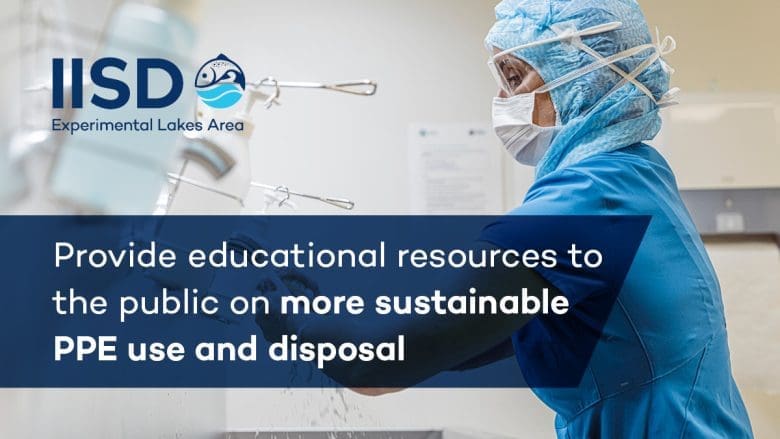Comment August 7, 2020
COVID-19 Has Canada Using More Single-Use Plastics. What impact will that have on our fresh water?
By Catherine van Rennen, Project Coordinator
Plastics are one of the most popular materials in existence. They are durable, relatively inexpensive to produce, and versatile enough for use in a diverse range of products.
Here in Canada, less than 10% of plastics are recycled, contributing to over 3 million tonnes of plastic being thrown into landfills or into the environment each year. Over a third of plastics produced in Canada are for single-use packaging or products—such as plastic bags, take-out containers, and bottlecaps—which constitute one of the largest sources of plastics found in fresh water.
What Impact Do Plastics Have on Fresh Water?
Plastics are released into our freshwater systems in many different shapes and sizes, and through various means—including wastewater treatment plants, landfill leakage, storm drainage, agricultural runoff, effluent and scraps from industry, inadequate waste management procedures, and litter.

Over time, environmental conditions—such as wind, rain, waves, and sun—cause plastics to break down into smaller pieces (< 5 mm) called microplastics.
Over the past few years, the study of microplastics has grown immensely, but much is still unknown about their short- and long-term ecological effects. As an emerging threat to freshwater environments with potential human health implications, further scientific research on the sources, fate, and effects of microplastics is critical.
How Has COVID-19 Impacted Plastics Usage and the Health of Our Fresh Water?
As part of the changes to our daily life brought about by COVID-19, Canadians’ reliance on certain types of single-use plastics has increased. Policy-makers are also facing pressure to reverse or suspend legislation that would address plastic waste and pollution, such as Canada’s proposal to ban harmful single-use plastics by 2021.
For example, at theheight of the outbreak, some provincial health officials advised against usingreusable bags and containers in grocery stores, with several chains banningthem outright in favour of plastic bags. Although many of these restrictionsare now being lifted, it may still be a while before consumers return to reusable bags and coffee cups.
COVID-19 has also brought a new source of plastic pollution in the form of single-use personal protective equipment (PPE), such as masks and gloves. Single-use PPE is a necessary and effective public health measure, but these products are not always discarded properly and may end up as litter that enters our waterways. Indeed, a recent study identifies plastic face masks as a potential source of microplastic fibres in the environment. Although research is already underway to develop biodegradable or recyclable masks, even a temporary surge in plastic litter can lead to long-term impacts for freshwater environments.
What Needs to Happen Now?
First up, researchers at IISD Experimental Lakes Area have already proposed a whole-lake experiment (in this case, by carefully and safely adding microplastics and closely monitoring the ecosystem), to allow us to better understand the impacts on the whole lake and food web that it supports.

More than 50 years of existing data about the chemistry, biology, and weather patterns at the site will help us understand and validate what we discover. And once we know more about what microplastics do to our freshwater lakes and the aquatic life residing within, we can then work directly with governments and industry to develop relevant and effective policies and procedures that protect our precious freshwater resources from plastics pollution.
When it comes to larger policy changes to reduce the impacts of COVID-19 on plastic pollution in our fresh water, the Government of Canada should:
Move forward with the Canada-wide strategy on zero plastic waste: Canada should proceed with implementing its existing strategy and legislation on plastic waste reduction, including a ban on harmful single-use plastic items by 2021.

Provide educational resources to the public on more sustainable PPE use and disposal: Use social media and traditional marketing campaigns to raise public awareness about proper disinfection, reuse, and disposal of PPE to help ensure we do not produce excess waste and that it does not end up as litter in our environment, including fresh water.

Invest in research and innovation on plastic pollution in fresh water as part of sustainable recovery measures: Part of Canada’s action plan to ensure a green recovery from COVID-19 should include the implementation of financial programs and incentives for small businesses, entrepreneurs, and researchers to develop innovative and sustainable solutions to reduce and prevent plastic pollution in fresh water, as well as better understand its effects.

Support and develop sustainable plastic waste management systems: The federal government needs to work in collaboration with industry, provinces, territories, municipalities, and Indigenous governments to coordinate localized and harmonized waste management procedures, as well as invest in appropriate infrastructure and markets to help implement a circular economy for plastics within Canada.

You know that ground-breaking freshwater research you just read about? Well, that’s actually down to you.
It’s only thanks to our generous donors that the world’s freshwater laboratory—an independent not-for-profit—can continue to do what we do. And that means everything from explore what happens when cannabis flushes and oil spills into a lake, to how we can reduce mercury in fish and algal blooms in fresh water—all to keep our water clean around the world for generations to come.
We know that these are difficult times, but the knowledge to act on scientific evidence has never been more important. Neither has your support.
If you believe in whole ecosystem science and using it to bring about real change to fresh water around the globe, please support us in any way you are able to.